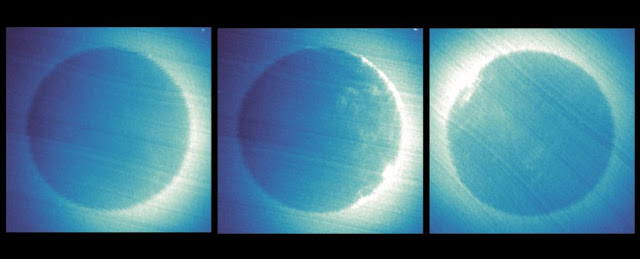A map of solar wind raining down on the planet.
 |
Images from the Hope Probe showing Mars with no aurora
(left) and patchy proton aurora (middle and right). (EMM/EMUS) |
We have new insight into a wonderful Martian phenomenon, thanks to a collaboration between two orbiting space probes.
NASA's Mars Atmosphere and Volatile Evolution (MAVEN) and
the United Arab Emirates' Hope Probe have joined forces to study the
ultraviolet proton auroras that dance and glow high up in Mars' atmosphere.
The new research reveals that these daytime events aren't
always diffuse, featureless and evenly distributed, but highly dynamic and
variable, containing fine-scale structures.
"EMM's (Emirates Mars Mission) observations suggested
that the aurora was so widespread and disorganized that the plasma environment
around Mars must have been truly disturbed, to the point that the solar wind
was directly impacting the upper atmosphere wherever we observed auroral
emission," says planetary scientist Mike Chaffin of the University of
Colorado Boulder.
"By combining EMM auroral observations with MAVEN
measurements of the auroral plasma environment, we can confirm this hypothesis
and determine that what we were seeing was essentially a map of where the solar
wind was raining down onto the planet."
Proton aurorae – the most common aurorae on the red planet –
were first described in 2018, as seen in MAVEN data. They form fairly similarly
to how aurorae on Earth form; however, since Mars is a very different beast,
without an internally-driven magnetosphere like Earth's, the end result is
unique to Mars.
The closest the red planet does have to a global magnetic
field is a flimsy one induced by the buzz of charged particles decelerating as
they smack into the atmosphere. As weak as it is, it is usually adequate enough
to deflect many of the high speed protons and neutrons raining down from the
Sun.
The proton aurorae form when positively charged protons in
the solar wind collide with Mars' hydrogen envelope and become ionized,
stealing electrons from hydrogen atoms to become neutral.
This charge exchange allows the neutral particles to bypass
the magnetic field's bow shock around Mars, raining down in the upper
atmosphere and emitting ultraviolet light.
It was thought that this process reliably produced uniform
auroral emission over Mars' dayside. The new observations show otherwise.
Rather than the smooth profile expected, the data from the
Hope Probe shows that, sometimes, the aurora is patchy, suggesting that there
can be unknown processes at play during the formation of these aurorae.
This is where MAVEN enters the picture. NASA's orbiter
carries a full suite of plasma instruments, for probing the solar wind,
magnetic environment, and thermal ions in the space around Mars.
It simultaneously took measurements while Hope imaged the
strange aurorae, and the combined data allowed the scientists to reconstruct
the reason behind it.
Diagram comparing the formation mechanisms of normal and
patchy proton aurorae. ( Emirates Mars Mission/UAE Space Agency) |
"By examining multiple Emirates Mars Mission
observations of patchy aurora that have different shapes and locations, and
combining these images with plasma measurements made by NASA's Mars Atmosphere
and Volatile EvolutioN mission, we conclude that a number of processes can
produce patchy aurora," the researchers write in their paper.
"This patchy aurora is mostly the result of plasma
turbulence, which under some circumstances leads to direct deposition of the
solar wind across the entire Martian dayside."
In other words, a rare chaotic interaction between Mars and
the solar wind is responsible for the patchy aurora; although it's not entirely
clear what the impact is on the Martian surface.
It's possible, however, that there are implications for
long-term atmosphere and water loss; without a global magnetic field, Mars is
continuing to lose both.
Interestingly, the proton aurorae – both smooth and patchy –
can help us understand at least one of these, since the hydrogen involved is
partially being created by water in the Martian atmosphere leaking into space.
"Many future data and modeling studies will be
needed," the researchers write, "to tease out the full implications
of these conditions for Mars atmospheric evolution."





0 Comments